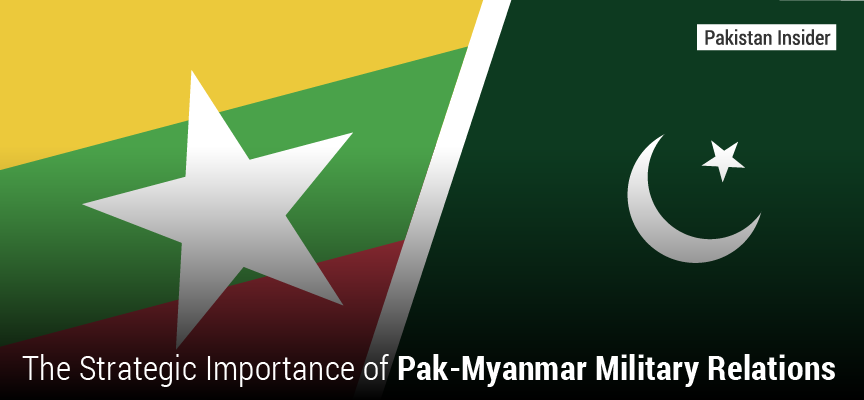Pakistan’s relations with Myanmar (formerly ‘Burma’) go back to 1947 when the Union of Burma and East Pakistan shared borders. Despite the independence of Bangladesh, both countries continue to maintain bilateral relations; since 1988, Pakistan and Burma each have embassies in each other’s capital.
As recently as 2012, then President Asif Ali Zardari visited Myanmar to promote trade, economic and energy cooperation between the two Asian countries. Many hailed the event as a landmark in Pak-Burmese relations.
Background
Pakistan and Myanmar established formal military relations in 1952. During the Indo-Pakistani War of 1971 which saw India-backed Mukti Bahini break off East Pakistan, a large number of Pakistani soldiers were being taken as Prisoners Of War (POWs). Fortunately, several army and mostly Pakistan Air Force (PAF) personnel were given safe passage by the state of Burma. In his monumental memoir ‘Witness To Surrender’ which documents a Pakistan Army POW’s perspective on the 1971 war, Brigadier Siddique Salik Shaheed (on page 209) gave examples of personalities such as Commanding Officer, Army Aviation squadron Eastern Command Lt Col Liaquat Bokhari and GOC 39th Ad Hoc Division Major General Rahim Khan escaping to Burma for protection against Indian Army and Mukti Bahini militants.
After the emergence of Bangladesh and unification of Western Pakistan into the Islamic Republic of Pakistan, relations between Pakistan and Myanmar never resulted in anything meaningful for quite a long period of time. The Cold War era followed by Pakistan’s engagement in a post-9/11 world did not allow Pakistan the time and space to hold any meaningful strategic dialogue with Myanmar. More importantly, the issue of Rohingya Muslims being persecuted at the hands of Buddhist militants has embedded displeasure and, in most cases, severe anger and resentment, among ordinary Pakistani Muslims.
Things began to change in ex-Pakistan Army chief General Ashfaq Parvez Kayani’s era. Not only did Kayani facilitate a fresh attempt at communicating with his Russian counterparts, Myanmar’s military junta was also approached keeping in view Pakistan’s growing (and still increasing) displeasure with the US after a spate of embarrassing incidents. It was Kayani who introduced the ‘Look East’ concept in the Pakistan Army, a branch of the Pakistan Armed Forces which has otherwise been the most dependent on technology and training concepts from US military institutions since Ayub Khan’s era.
It was reported in June 2013 that around 20 officers from Myanmar Navy visited Karachi in late April/early May to begin basic submarine training with Pakistan Navy at PNS Bahadur. The same month, it was also reported separately that
Major General Soe Shein, then head of Military Affairs Security (Myanmar’s primary intelligence service), visited Pakistan with a delegation of 22 senior officials for discussions on a range of issues. The delegation had landed in Lahore where they were received by then Corps Commander Lahore, Lt General Maqsood Ahmad.
In August 2014, Air Chief Marshal Tahir Rafique Butt paid the first ever visit by a serving PAF chief to Myanmar where he met his counterpart General Khin Aung Myint (Commander-in-Chief of Myanmar Air Force). Both air chiefs discussed matters of professional interest. The PAF chief was introduced to various Principal Staff Officers (PSOs) of the Myanmar Air Force along with visits to an operational air base and several maintenance facilities.
On May 7, 2015, General Ming Haung Hlaing, Commander-in-Chief of Myanmar Defence Services (representing Burmese tri-services), visited Pakistan with a delegation. Among others, he met Chairman Joint Chiefs of Staff Committee General Rashad Mahmood, Chief of Army Staff General Raheel Sharif, Chief of Air Staff Air Chief Marshal Sohail Aman and Chief of Naval Staff Admiral Muhammad Zakaullah to discuss avenues of cooperation in a variety of military spheres. In particular, he discussed regional and “local” issues with the Pakistani Joint Chief. Although no specific details have been made available, it can be speculated that the issue of Rohingya Muslims and threats from India were discussed.
On May 21, 2015, Commander-in-Chief of Myanmar Air Force General Khin Aung Myint visited Air Headquarters, Islamabad to discuss matters of mutual interest with PAF chief Air Chief Marshal Sohail Aman; Myint reciprocated the earlier visit by Sohail Aman’s predecessor. Later, he also visited Pakistan Aeronautical Complex, Kamra where he and his team were given a detailed tour of the premises, especially the Sino-Pak JF-17 Thunder jet program. It seems the Myanmar Air Force delegation was so impressed with the JF-17 jet that they placed orders for it, thus making Myanmar the first foreign buyer of the advanced fighter jet jointly developed by China and Pakistan.
Myanmar’s Military – The ‘Tatmadaw’
The International Crisis Group (ICG), in its Asia Briefing No. 143 dated April 22, 2014, discussed in detail how Myanmar’s military, known as the ‘Tatmadaw’, put a leash on itself and transitioned from dictatorship to semi-civilian government/democracy. The changes witnessed are increasing, as more and more liberalization in politics, peace and economic issues has taken place.
Somewhat similar to their Pakistani counterparts, the Tatmadaw is skeptical about major political players and civilian officials who have either failed to deliver or are suspected of playing into enemy hands. Most importantly, keeping the sensitivity among various ethnicities in view, the Tatmadaw has been quite successful in quashing communal violence as compared to the police.
According to the ICG, the Tatmadaw’s increasing support for democratization and liberalization is to ensure national sovereignty while being mindful of geostrategic interests, especially in its immediate neighborhood and rocky ties with China and India.
If anything else, it is more than obvious that after the purported Indian special forces raid in Myanmar, the Tatmadaw must be fuming with anger at New Delhi for a long time. Even if we accept the alternative report that no such raid took place, the fact that India’s establishment sneered with arrogance on conducting such an operation will not be easily forgotten. Perhaps now Myanmar will not cast doubts on China’s sincerity to provide a dignified neighborhood for states to be part of. Furthermore, the Tatmadaw will be very cautious about future Indian ambitions and will ensure its intelligence on New Delhi’s hegemonic adventurism is regularly updated.
Persecution of Rohingya and Pak-Myanmar Military Ties
Keeping the concept of realpolitik aside, it is irrational to deduce that Myanmar’s military junta supports radical Buddhist elements who have been killing innocent Rohingya. This barbaric and savage act is a political-ethnic issue and not a military one. Accusing the Tatmadaw of endorsing Rohingya genocide is similar to someone accusing the Pakistan Army of supporting the killing of a minority community, assertions which could best be called ludicrous.
On the contrary, according to the detailed report by ICG:
“During the state of emergency in Rakhine in 2012, the military was far more effective than the police had been in restoring order and protecting Muslim Rohingya villages, and those communities generally saw its role as positive”.
The Tatmadaw has no interest in killing Rohinyas; the details in the above-mentioned report explain how and why the Tatmadaw is struggling to modernize itself along a new mode of thinking.
The China-Pakistan-Myanmar Nexus: Thorn for India
The last thing India needs is a nexus between China, Pakistan and Myanmar. Myanmar’s animosity for New Delhi can be betted upon, especially after the recent cross-border raid by India.
In the growing regional dynamics, China is emerging as a world power which can effectively alter the course of events in Asia’s history into a more developed, peaceful and harmonious bloc. Analyst Kamal Alam rightfully concluded his op-ed on warming Pak-Myanmar ties by saying that Pakistan Army needs Myanmar to counterbalance India’s growing influence in Southeast Asia. With Indian meddling in Afghanistan to the west, Pakistan needs a stable strategic ally to India’s east which could prove reliable in times of crises (as in 1971).
China and Pakistan greatly benefit from Myanmar’s strategic location; with China to the north, Myanmar to the east, Sri Lanka to the south and Pakistan itself to the west, India’s overzealous ambitions to become a ‘regional superpower’ can be rigorously monitored. This is precisely why India goes paranoid when it starts imagining the “Chinese ring” around itself.
In his 2009 book ‘Look East Policy and India’s North East: Polemics and Perspectives’, Dr. Thingnam Kishan Singh wrote about this feared “Chinese ring” in the following words (pgs 179-180):
“The Chinese maritime expansion in the Bay of Bengal and Arabian Sea with the logistic support of Myanmar and Pakistan respectively has created a situation of perceived Chinese encirclement of India. In fact, Chinese maritime expansion and inroads into the Indian Ocean through Myanmar is a cause of serious concern for India mainly in the light of Chinese assertion that the Indian Ocean is not India’s Ocean…….Besides, the Chinese presence all along the Myanmar’s border is perceived as a direct threat to India’s security. As such, the strategic concern caused by Myanmar-Pakistan-China nexus in an attempt to encircle India in the long run entails the need on the part of India to reverse its foreign policy in dealing with the military regime of Myanmar.”
Was the purported raid in Myanmar by Indian special forces a sign of this policy reversal?
From a geostrategic and purely military perspective, Pakistan could formally request Myanmar authorities to allow PAF jets to use its airspace for any future wars, including a non-operational rented air base which could be activated only if aggression by a foolish adventurist state needs a befitting response. In return, Pakistan’s military can continue to offer better training, resource and other facilities to the Tatmadaw; the reported sale of JF-17s to Myanmar appears to be the first step in this direction.
Conclusion
Pakistan’s military relations must not be viewed from an emotional lens or based on quite unsubstantiated reporting. While it is true that a certain lot of Buddhist militants have killed scores of Rohingya, nowhere does it warrant the severing of Pak-Myanmar ties.
India is already irked by news of JF-17 being sold to Myanmar. To ensure equal, unrestricted access to the Indian Ocean, a China-Pakistan-Myanmar strategic alliance will most certainly prove beneficial.








yes ,correctly said and analyzed from the present perspective .